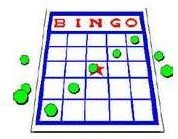Interactive Classroom Phonics Games for Elementary Students
Preparation
For phonics games for children use a blank template for a bingo card or you can make your own. Then make multiple copies. To save paper, use both sides of the paper to copy the blank bingo card. Use inexpensive plastic poker chips as markers. To save time, keep a handful of chips in individual zippered plastic bags. That way, each student can grab a bag of chips and a blank bingo card. On special days you may want to use cereal, small pretzels or candy as markers.
Fill in the Blanks
Let’s suppose you are practicing beginning consonants with your class. Write the consonants on the board. For the first few times, you want to be very specific with the directions:
Write one consonant in each square on your bingo card.
You can mix them up as you write them on the card.
Use each consonant only once.
Depending on the number of squares on the card, you may not use all the consonant choices.
If you have access to an overhead projector, you may want to demonstrate how to fill in the card. It’s good to spend some time on making sure they understand. As you continue to use the bingo card template for phonics games for children, it will take less preparation time. Remember to save them for another time!
It’s Play Time!
Have a prepared list of words with a variety of beginning consonants. You may want to include reading or spelling vocabulary on which your students are currently working. Call out individual words. Students place a marker on the beginning consonant that they hear. Student calls out “Bingo” if they have a diagonal, vertical or horizontal row completely filled in.
You may decide that the winning student can call out the next round of words. Have the student think of the words on his/her own. You should keep track of the words the student calls out.
Variations!
Letter recognition–call out a letter and the student covers that letter on their card.
Hold up a capital “upper case” letter and the student covers the matching “lower case” letter.
Dictionary skills (abc order) Call out a letter and the student covers the letter that comes before.
Call out a letter and cover the letter that comes after in the alphabet.
Say a word and have the student cover the ending sound they hear.
Use vowel sounds on the cards
Consonant combinations (th,ph,st,sch,sk,wh,sh,str,br,bl,sl,sp,)
Use Rhyming words or word endings (_ock, _ime, _oon, _ ate, _an, _at, _and, _oy, _amp, oat, ox, _ug, _ish, _un, _ike, _eep, _us, _ig)
Antonyms or synonyms
These games can be used to add a fun activity while reviewing various skills. Use it after recess to settle back down in the class routine. Keep it handy so that it can be efficiently distributed and collected to maintain class control. A winner all the way around!
Reference
Ideas and activities come from the author’s twenty-five years of teaching experience.
